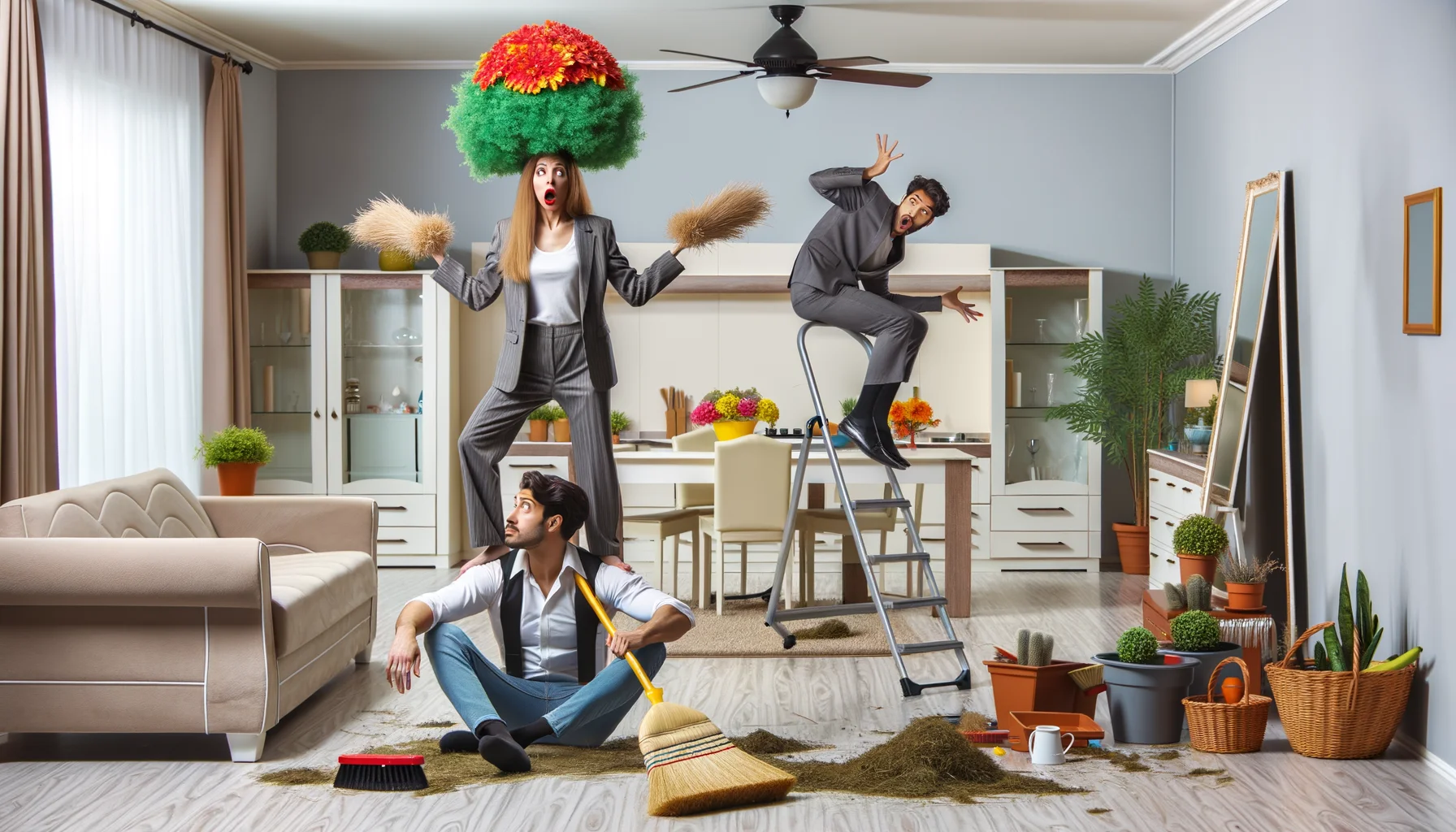Home staging tips for sellers Quiz
Test Your Knowledge
Question of
Understanding Home Staging
The Concept of Home Staging
Home staging is a strategic marketing tool used to highlight a property's best features and help prospective buyers envision themselves living there. It involves decluttering, decorating, and arranging furniture and decor to make the home more appealing. The ultimate goal is to present a home in its best light, making it more attractive to a broad range of buyers.
Enhancing Curb Appeal: The exterior of your home is the first thing potential buyers see, making it crucial to create a positive first impression. This can involve landscaping, painting the front door, or adding outdoor lighting. A home with great curb appeal can stop traffic and stir up excitement before the buyer steps inside.
Maximizing Space Perception: Stagers know how to maximize the perception of space through clever furniture arrangement and by reducing clutter. The right layout can help rooms appear larger and more inviting, which is incredibly important in real estate where space is a premium commodity.
Neutralizing Personal Decor: Personal tastes vary widely, so stagers often recommend neutralizing decor to reach a wider audience. This means replacing bold color schemes with more subdued palettes and removing family photos or personal collections that could distract buyers from envisioning their own lives in the space.
Benefits of Home Staging for Sellers
Faster Sales Time: A well-staged home typically spends less time on the market. Buyers are often more willing to make an offer on a home that looks move-in ready rather than one that needs work or imagination to see its potential.
Potential for Higher Offers: If a home is staged effectively, it not only sells faster but may also garner higher offers. A beautiful presentation can lead to emotional purchases, where buyers are willing to pay top dollar for a house that feels like their dream home.
- Depersonalize spaces by removing family photos and personal items.
- Declutter each room to enhance the feeling of spaciousness.
- Rearrange furniture to showcase each rooms purpose and flow.
- Use neutral colors for walls and major decor elements.
- Add touches of greenery or fresh flowers for vibrancy.
- Ensure all areas are well-lit and inviting.
- Clean thoroughly every nook and cranny counts!
- Address any maintenance issues before showing the home.
Creating a Memorable First Impression: In today's fast-paced real estate market where many listings are viewed online first, staging can make your property stand out from the rest. A memorable first impression can be the difference between a buyer scrolling past or deciding to visit in person. It sets the stage for an emotional connection that can lead to a successful sale.
Preparing Your Home for Staging
Decluttering Essentials
Before you even think about home staging, let's tackle the clutter! Clearing out excess items is crucial; it makes your space look bigger and more inviting. Think about it like a blank canvas, allowing potential buyers to picture their own lives in your home. Start by removing personal photos, bulky furniture, and anything that doesn't serve a purpose.
A decluttered home sells faster, so roll up those sleeves! It's all about creating a serene environment that shouts 'Buy me!'. Keep countertops clean and closets tidy. Less is definitely more here, giving each room a clear function and showcasing the available space.
Sorting Household Items
As you dive into sorting household items, categorize them into 'keep', 'sell', 'donate', or 'trash' piles. This method streamlines the process and keeps you organized. Tackle one room at a time to avoid feeling overwhelmed and keep track of your progress.
Organizing Spaces
Once you've sorted everything, it's time to neatly organize what's left. Use baskets and storage bins to stow away everyday items. Remember, closets and drawers will be opened during showings, so make sure they're tidy too!
Disposing of Unwanted Goods
Don't let unwanted goods take up precious space! Plan a yard sale or list items online to sell them quickly. For donations, many organizations will pick up large items if scheduled in advance. Anything that cant be sold or donated should be responsibly disposed of at local waste facilities.
Deep Cleaning Strategies
A spotless home is non-negotiable when staging! It suggests well-maintained property and appeals to buyer cleanliness standards. Every surface should sparkle, from ceiling fans down to baseboards. Hire professional cleaners if needed; this investment often pays off by attracting higher offers.
Evoke the feeling of a brand new home with your cleanliness it can make or break a sale!
Focus on Kitchens and Bathrooms
Kitchens and bathrooms sell homes, so these areas deserve extra attention! Make sure appliances shine and countertops are free from stains or crumbs. In bathrooms, fresh grout, sparkling fixtures, and streak-free mirrors make a world of difference.
Carpet and Floor Care
- Vacuum daily: This prevents build-up of dirt and dust particles that can dull the appearance of your carpets.
- Spot Clean Spills Immediately: Quick action can prevent permanent stains.
- Hire Professionals: For deep cleaning or challenging stains, bringing in professionals can rejuvenate old carpets.
- Maintain Hard Floors: Sweep regularly and use the right cleaning solutions for wood or tile floors.
- Rugs as Accents: Clean accent rugs can add color while hiding less attractive flooring areas.
Eliminating Odors and Stains
Banish odors to ensure your home smells as clean as it looks. Open windows to air out rooms regularly. Use baking soda on carpets before vacuuming to absorb smells. For stubborn stains or odors, consider calling in the experts for specialized treatments that could save your sale!
Design Techniques for Staging
Color Schemes and Themes
When it comes to staging a space, the power of color cannot be overstated. Color sets the mood and creates the ambiance for any room. Selecting the right color scheme is critical in making a lasting impression. Its not just about personal taste; it's about choosing colors that resonate with a wide array of potential buyers or occupants.
Choosing Neutral Colors is a safe bet in staging. Neutrals serve as a blank canvas, allowing viewers to envision their own furnishings and decor in the space. They also make rooms appear larger and brighter, which is always a plus when showcasing a property.
In Coordinating Room Colors , consistency is key. You want to create a harmonious flow throughout the space. This doesnt mean every room should be painted the same color, but rather that the colors should complement each other. A cohesive color palette can seamlessly tie together the entire property.
Accentuating with Accessories is where you can add pops of color and personality. Think pillows, artwork, or decorative items that can inject life into a room without overwhelming it. These accents can draw attention to the propertys best features and add character to the space.
Furniture Placement and Flow
The arrangement of furniture is pivotal in creating an inviting atmosphere. Proper placement can enhance room functionality while showcasing its potential. The goal is to demonstrate how spaces can be utilized efficiently while maintaining aesthetic appeal.
Arranging for Spaciousness involves strategic positioning of furniture to maximize space. Less is often more in staging; overcrowding rooms with furniture can make them feel cramped. Instead, select pieces that are proportional to the room size and place them in a way that promotes an open feel.
- Avoid blocking windows or pathways with furniture to allow natural light and easy movement.
- Use area rugs to define spaces without enclosing them.
- Maintain balance by evenly distributing furniture and not overloading one part of the room.
- Choose furniture that serves multiple purposes, such as ottomans with storage, to minimize clutter while maximizing utility.
Highlighting Key Features means using furniture to draw attention to a rooms assets, like a fireplace or an exquisite view. Arrange seating around these features or use lighting to spotlight them.
Ensuring Easy Navigation through rooms is essential for good flow. There should be clear paths that guide people through each space without obstruction. Its important for potential buyers or guests to move freely and comfortably, fostering positive impressions of the propertys layout and design.
Enhancing Curb Appeal
Exterior Improvements
Landscaping and Gardening
The front yard is a home's handshake, greeting guests with a taste of what's inside. Thoughtful landscaping and well-maintained gardens are essential. They create an inviting atmosphere that can significantly boost your home's curb appeal.
Investing in perennial plants ensures year-round greenery, while seasonal flowers add a splash of color. Keeping the lawn trimmed and incorporating native plants can also enhance the homes exterior without requiring excessive maintenance.
Updating Exterior Fixtures
It's all in the details! Upgrading fixtures like house numbers, mailboxes, and door handles can make a surprising difference. These elements should not only be functional but also reflect the home's style, adding character and modernity.
Consider the materials and finishes of these fixtures to ensure they withstand weather conditions while complementing the home's architecture. A cohesive look can tie together the homes overall aesthetic.
Painting and Siding Touch-Ups
A fresh coat of paint can work wonders for a tired exterior. Choose colors that suit the architecture but also stand out in the neighborhood. Remember, neutral tones often attract a broader audience if selling is on the horizon.
Siding should be kept clean and in good repair. Pressure washing to remove dirt and grime can revive the appearance dramatically without the need for painting every time.
Entryway Makeover Tips
Welcoming Door Design
The front door is more than just an entry point; it's a statement piece. A bold color or unique design can serve as a visual centerpiece, drawing eyes and interest.
A well-crafted door suggests quality and security, two features that shouldn't be overlooked when considering curb appeal enhancements.
Porch and Patio Decor
- Create Symmetry: Symmetrical arrangements are pleasing to the eye and easy to achieve with planters or light fixtures flanking the doorway.
- Seating Arrangements: Include comfortable seating options to make your porch feel inviting and lived-in.
- Add Personality: Personal touches like welcome mats or seasonal decorations convey warmth and charm.
- Maintain Cleanliness: Regularly sweep away debris and cobwebs to keep the area looking cared-for.
- Vary Heights: Use decor of different heights to create depth and keep the eye moving.
- Durable Materials: Choose materials that will withstand weather conditions to keep your decor looking great over time.
Lighting for Ambiance
The right lighting sets a mood; it welcomes guests after dusk with warmth and visibility. Consider energy-efficient LED options for longevity and lower energy costs.
Solar-powered path lights add elegance without additional wiring, while porch lights should illuminate the entrance clearly without being harsh or overly bright.
Setting the Stage with Lighting
Natural Light Optimization
Unlocking the potential of natural light can transform your space from dull to dazzling. It's not just about having big windows; it's about making sure those windows are crystal clear. Regular window cleaning boosts transparency, allowing every precious ray of sunlight to permeate your room, enhancing the ambiance without a single watt of electricity.
Mirrors are magicians when it comes to amplifying light! Strategic placement of mirrors opposite to windows can double the impact of natural light, spreading it throughout the room. It's like having an extra window without the construction costs! A well-placed mirror reflects light into darker corners, making your space feel larger and more inviting.
Don't let overgrown bushes or trees cast a shadow over your beautiful, light-filled room. Trimming outdoor vegetation regularly ensures that branches and leaves don't obstruct sunlight from entering through the windows. It's a simple yet effective way to maintain a bright and airy atmosphere in your home or office.
Artificial Lighting Techniques
The art of artificial lighting lies in mastering the blend of different light sources. Layering light involves using a combination of ambient, task, and accent lighting to create depth and character in a room. This technique allows for flexibility in setting the mood and functionality for various activities within the space.
When it comes to bulbs, one size does not fit all! Choosing the right bulbs is crucial for achieving desired lighting effects. Consider color temperature and lumens based on whether you're looking for warm, cozy lighting or bright, energizing illumination. LED bulbs offer energy efficiency and longevity, making them a smart choice for both your wallet and the planet.
- Install Dimmer Switches: They allow you to adjust lighting levels easily, setting the perfect mood for any occasion.
- Smart Lighting Controls: Use smart bulbs or systems that can be controlled via smartphone apps for ultimate convenience.
- Zoning Your Lights: Group lights by area so you can control different sections independently, saving energy while catering to specific needs.
- Timers and Sensors: Automate your lighting with timers or motion sensors for security and efficiencylights on when needed, off when not.
- Scene Setting: Pre-program scenes for activities like reading or dining that adjust multiple lights at once to your preferred settings.
Incorporating dimmers and controls not only adds versatility to your lighting but also helps in reducing energy consumption. Dimmers can extend bulb life and offer significant savings over time. With modern advancements in home automation, controlling your lighting has never been easier or more efficient!
Accessorizing and Detailing
Artwork and Wall Hangings
When it comes to transforming a room, artwork and wall hangings are game-changers. They add personality and can tell a story about your space. It's crucial to select pieces that resonate with you and complement the room's existing color scheme and decor style. Remember, the art you choose is a reflection of your taste and can become a conversation starter.
Selecting Appropriate Sizes for your artwork is essential for visual harmony. A large empty wall calls for a substantial piece or a gallery-style arrangement of smaller works. Conversely, in more intimate spaces, smaller pieces can create a sense of sophistication without overwhelming the area. Balance is keyensure that the scale of your art complements rather than competes with furniture and architectural elements.
Creating Focal Points with wall hangings can define a rooms ambiance. Consider placing an eye-catching piece above the mantelpiece or sofa to draw attention. Lighting can also play a significant role in highlighting your artwork and elevating its impact within the space. Aim for lighting that enhances the colors and details without causing glare or damage over time.
To Maintain a Cohesive Style , ensure your wall hangings mesh well with the theme of your room. Whether it's modern abstracts for a contemporary space or classic landscapes for a traditional decor, consistency is vital. Don't be afraid to mix mediums; just keep a common thread running through your choices to unify the look.
Textiles and Soft Furnishings
Textiles bring warmth and texture to any living space. They're not just functional; they're an integral part of your decor's aesthetic appeal. From lush throw pillows to cozy blankets, textiles are an effortless way to refresh your room's look with seasonal trends or inject new color palettes without major overhauls.
Coordinating Throw Pillows and Blankets can add depth and interest to any sofa or chair. Mix patterns with solids, but stick to a consistent color scheme for unity. Textural contrasts such as smooth silk against nubby linen can enhance tactile appeal while keeping the visual flow intact.
The way you Dress Beds and Windows has a tremendous impact on both comfort and style. Opt for layers on beds: crisp sheets topped with quilts or comforters, finished with decorative pillows create an inviting retreat. Similarly, window treatments should offer both function and flairthink blackout curtains paired with sheer drapes for versatility in light control and privacy.
- Selecting Rugs : Choose rugs that complement the rooms dimensions; large rooms can handle bold patterns while small spaces benefit from lighter hues that make them feel more expansive.
- Rug Placement : Position rugs thoughtfullyunder furniture to anchor seating areas or as standalone pieces to define zones within open-plan spaces.
- Rug Material : Consider rug material for durability; wool for high-traffic areas, soft cottons for bedrooms, or easy-to-clean synthetics for dining spaces.
- Rug Care : Regular maintenance ensures longevity; vacuum frequently, attend to spills promptly, and rotate rugs periodically to even out wear.
Selecting rugs isn't just about finding a pattern you loveit's about enhancing comfort while tying together your interior design elements. A rug acts as an anchor in any room setting, defining areas while adding an extra layer of texture and warmth underfoot. When choosing a rug, consider how it will interact with other textiles in the room for seamless integration into your decor scheme.
Addressing Repairs and Maintenance
Minor Repairs Impact
Don't underestimate the power of minor repairs! Small fixes can significantly boost a property's appeal, signaling to potential buyers or renters that the home is well-cared for. It's the little things that can make a big differencetightening a loose doorknob or securing a wobbly railing can prevent negative impressions.
Fixing Leaks and Squeaks : Address those annoying little issues like leaky faucets or squeaky doors before they become big turn-offs. Promptly repairing these not only prevents further damage but also shows meticulous attention to detail, which is incredibly reassuring for prospective occupants.
Patching Walls and Ceilings : A flawless finish on walls and ceilings is paramount. Patching up holes or cracks and a fresh coat of paint can breathe new life into any space, making it appear brighter and more inviting.
Updating Hardware and Fixtures : Modernizing outdated hardware and fixtures is a cost-effective way to add charm. Swapping out old cabinet handles or dated light fixtures can instantly modernize a room, making it more attractive without breaking the bank.
Ongoing Maintenance During Showings
Maintaining your property during showings is crucial for leaving a lasting impression. Daily upkeep ensures that every visitor experiences the property at its best. This consistent effort can be the deciding factor in closing a sale or securing a lease.
Daily Cleaning Routine : Implementing a daily cleaning routine keeps the property showroom-ready at all times. Focus on high-traffic areas and maintain spotless bathrooms and kitchens, as these are critical in influencing prospects' decisions.
- Quickly vacuum or sweep floors to eliminate any dust or debris.
- Wipe down surfaces after each showing to maintain a pristine environment.
- Ensure there are no lingering odors by ventilating rooms and using subtle air fresheners.
- Keep personal items out of sight to allow visitors to envision themselves in the space.
Keeping Landscaping Tidy : First impressions count, and curb appeal plays an integral role. Regularly trim hedges, mow lawns, and remove weeds to showcase the property's exterior at its finest. Well-maintained landscaping suggests that the rest of the property is equally cared for.
Managing Wear and Tear : Regular use inevitably leads to wear and tear. Stay vigilant about scuffs on walls, worn carpets, or loose tiles. Addressing these promptly ensures that the property remains in top condition, preventing cumulative deterioration over time.
Final Touches Before Listing
The Art of Depersonalization
Transforming your home into a buyer's dream starts with depersonalization. It's time to pack away those personal photos and family heirlooms. This allows potential buyers to envision their own memories in the space, making it easier for them to fall in love with the home.
Are you a collector? Now's the moment to minimize your personal collections. Whether it's stamps, figurines, or sports memorabilia, storing these items will help declutter the space. A neutral backdrop appeals to a wider audience, increasing your chances of a quick sale.
It's also crucial to neutralize unique decor choices that might not align with everyone's taste. Bold wall colors or eccentric wallpaper can distract buyers. Opt for soft, neutral hues that create a blank canvas for buyers to project their own ideas onto.
Creating an Inviting Atmosphere
An inviting atmosphere can make all the difference when showcasing your home. Setting the dining table elegantly can suggest a warm, communal space. Use simple yet sophisticated place settings to enhance appeal without overwhelming the senses.
Add an element of life and color with fresh flowers arranged tastefully around the house. Not only do they add beauty, but they can also emit a subtle, pleasant fragrance that makes for an unforgettable open house experience.
- Ensure Comfort: Keep your home at a comfortable temperature during viewings not too hot or too cold.
- Lighting Matters: Open curtains and blinds during daytime showings for natural light, and ensure all bulbs work for evening tours.
- Ambient Music: Soft background music can create a relaxing environment that allows buyers to comfortably explore.
- Cleanliness is Key: A spotless home is non-negotiable. Ensure every room is clean and tidy before each showing.
- Pet Considerations: Remove pets during showings and eliminate any pet-related odors or stains.
- Avoid Strong Scents: While pleasant fragrances are nice, overpowering smells can be off-putting. Stick to mild, fresh scents.












